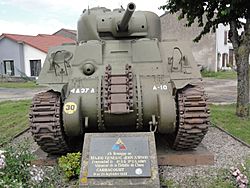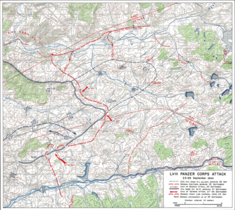Battle of Arracourt facts for kids
Quick facts for kids Battle of Arracourt |
|||||||
|---|---|---|---|---|---|---|---|
| Part of the Lorraine Campaign of World War II | |||||||
 Arracourt commemorative monument |
|||||||
|
|||||||
| Belligerents | |||||||
| Commanders and leaders | |||||||
| George Patton Bruce C. Clarke |
Hasso von Manteuffel | ||||||
| Units involved | |||||||
|
5th Panzer Army
|
||||||
| Strength | |||||||
| unknown | 262 tanks & assault guns | ||||||
| Casualties and losses | |||||||
|
41 medium tanks
|
200 tanks & assault guns lost
During the battle, 73 tanks were destroyed / damaged by P-47s.
|
||||||
The Battle of Arracourt was a major tank battle. It happened between American and German forces. The fight took place near Arracourt, France. This was from September 18 to 29, 1944. It was part of the Lorraine Campaign during World War II.
Germany's goal was to take back Lunéville. They also wanted to destroy a U.S. bridgehead. The Germans had more troops and tanks. They thought they would win easily. But the U.S. forces had better plans. They used the land to their advantage. They also had great air support. The U.S. won the battle.
Contents
Who Fought?
German Forces
The German army had 262 tanks and assault guns. They had two panzer (tank) brigades. These included the 11th Panzer Division. Many of their tanks were new Panther tanks. But the tank crews were new too. They had only two weeks of training. They were not good at reading maps. They also had little fuel. This meant they couldn't practice much.
American Forces
The U.S. forces were from the 4th Armored Division. They were called Combat Command A (CCA). Colonel Bruce C. Clarke led them. They had tank battalions and infantry. They also had artillery and tank destroyers.
The German Panther tanks were stronger. Their front armor was better than the American M4 Sherman tanks. Their main guns could shoot farther. But U.S. tanks had faster turrets. They also had special stabilized guns. The U.S. also had a huge advantage in air support. U.S. fighter-bombers attacked German units. This stopped some German tanks from even reaching the battle.
The Battle Begins
On September 18, 1944, heavy fog covered the area. U.S. planes could not see German tanks. So, they couldn't attack them from the air. But the fog also made it hard for the Germans. They couldn't see well either. They also lacked scouting units. This meant their attacks were messy.
The first German attack hit near Lunéville. This was on September 18. U.S. forces fought back hard. They destroyed two dozen German tanks. The U.S. commanders thought it was a small attack. But more German activity was reported. So, the U.S. postponed their own plans. The German army then moved north. They went around Lunéville. They attacked CCA's position near Arracourt. This became one of the biggest tank battles on the Western Front.
Fighting in the Fog
On September 19, German tanks broke through U.S. outposts. They reached close to CCA's headquarters. U.S. tank destroyers and tanks fought them. Even U.S. artillery units fired directly at the German tanks.
The German tanks were not well placed. Their weaker side armor was exposed. U.S. Shermans used the fog to hide. They moved around the German tanks. They knocked out 11 panzers. The Germans had to advance without knowing where the U.S. was. The U.S. forces used hidden positions. They used higher ground. They also used clever "fire-and-maneuver" tactics. This helped them against the stronger German tanks. The fog helped the U.S. too. It made the longer range of German guns useless.
Air Support and Heroes
From September 20 to 25, the Germans kept attacking. On September 20, some U.S. support units were trapped. A U.S. pilot, Major "Bazooka Charlie" Carpenter, took off in his small plane. It was armed with bazookas. He was called Rosie the Rocketer. The fog lifted around noon. Carpenter saw German tanks. He dived down and fired his bazookas. He attacked the tanks many times. He returned to base to reload. He flew two more missions that day. He fired 16 bazooka rockets. He was credited with destroying two Panther tanks and several armored cars. His actions forced the Germans to retreat. This saved trapped U.S. crews.
On September 21, the skies cleared. U.S. Republic P-47 Thunderbolt planes attacked German forces. CCA could call in air strikes. The close teamwork between the U.S. ground and air forces was key. It helped destroy the German tank units.
End of the Battle
By September 24, fighting moved to Château-Salins. A German attack nearly overwhelmed a U.S. unit. But U.S. fighter-bombers routed them. The U.S. Third Army was then told to stop attacking. They had to hold their positions. On September 26, the 4th Armored Division went on defense. CCA moved to better ground. The German army had only 25 tanks left. They kept attacking for three more days. But the clear weather meant more U.S. air attacks. The Germans had to stop their counterattack. They began to retreat.
What Happened Next?
The Battle of Arracourt happened as the U.S. Third Army's fast advance across France ended. Fuel supplies were sent to other forces. This delay allowed the German army to regroup. They prepared to defend their border.
Arracourt was the biggest tank battle involving U.S. forces on the Western Front. This was true until the Battle of the Bulge. This battle showed that good tactics and trained crews are very important. They can be more important than how powerful the tanks themselves are.
Maps





